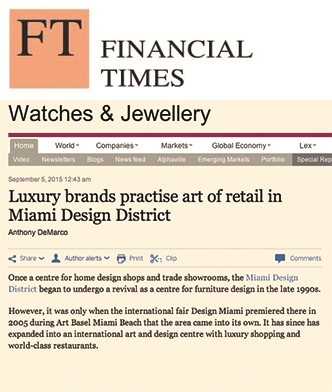

Luxury brands practise art of retail in Miami Design District
Anthony DeMarcoOnce a centre for home design shops and trade showrooms, the Miami Design District began to undergo a revival as a centre for furniture design in the late 1990s.
However, it was only when the international fair Design Miami premiered there in 2005 during Art Basel Miami Beach that the area came into its own. It has since has expanded into an international art and design centre with luxury shopping and world-class restaurants.
The latest phase in its revival is a dedicated “neighbourhood” for luxury jewellery and watch brands known as Palm Court. Of the 18 stores, 15 have opened and the remainder will do so next year. The majority are housed in a two-storey, blue-hued glass structure by Japanese architect Sou Fujimoto, his first project in the US. The remaining brands are located on the other side of the plaza.
A replica of Richard Buckminster Fuller’s Fly’s Eye Dome and a giant fibreglass bust of the architect Le Corbusier by French artist Xavier Veilhan are central art works in the plaza. This accords with the thinking behind the Design District — to house landmark buildings designed by world-class architects and incorporating works by internationally renowned artists.
The stores in the district represent the breadth and depth of independent and corporate-owned luxury watch and jewellery brands. Craig Robins, chief executive of Dacra, which has led the development, says the only city that may have something similar is Tokyo. “Miami is becoming a very important urban centre, probably the second or third most powerful luxury market in the US.”
Mr Robins, a modern art collector, philanthropist and co-founder of Design Miami, is one of the most influential developers in the city. “As we started to work with all the luxury brands we realised an incredible opportunity that virtually did not exist in the US — a concentrated, magnificent plaza featuring watch and jewellery brands,” he says.
Dacra owns all the real estate, allowing Mr Robins to create his vision for the area, including the retail environment. The final phase is expected to be completed at the end of 2016 and will include a boutique hotel, housing, a new home for the Institute of Contemporary Art, Miami and more luxury shopping and restaurants.
Those who bought into Mr Robins’s vision accept that the district is a work in progress.
“We think this will become an important area in the US in terms of art, in terms of design, in terms of shopping,” says Angelo Bonati, chief executive of Officine Panerai. The watchmaker opened its flagship boutique for the Americas in the Design District in July, created by the architect and designer Patricia Urquiola.
For Parmigiani Fleurier, the decision to locate its first US boutique in the Design District was straightforward. It has its headquarters in Miami, in nearby Wynwood. Thierry Collot, Parmigiani US president, is a resident of the city.
“We’re a small, independent brand and it was a well-considered strategy to have our only US boutique in Miami,” he says. “Miami is a great platform for us and the Americas in general.”
The A Lange & Söhne boutique opened in January. Wilhelm Schmid, chief executive of the German brand, is taking the long approach with the company’s investment, while also keeping his fingers crossed.
“[This] new part of Miami is a good opportunity for the future and that’s why we went there. Right now it looks promising but it’s very early. Call me a fool in a couple of years, or call me a very clever guy who went there in time.”
